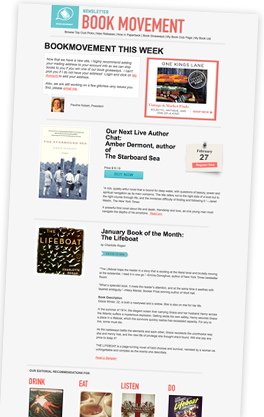
by Carol Rifka Brunt
Paperback- $6.48
NAMED ONE OF THE BEST BOOKS OF THE YEAR BY
The Wall Street Journal • O: The Oprah Magazine • BookPage • Kirkus Reviews • Booklist ...
Overall rating:
How would you rate this book?
Member ratings
I found this book interesting and worth reading but it won't go down as one of the best ever.
I was a bit confused with the wolf analogy between the significance of the painting, the tattoo,
and the main character.
This was not a book I would have chosen; the book club I\\\'m in did. I read it and found the book to be very emotional (I teared up a few times but really was crying at the end...I suggest having a box of Kleenex handy). I do not understand the title or the significance of the wolves, though. I hope someone at Sunday\\\'s book club will be able to explain it. There are a lot of things to discuss as there are plenty of themes in this novel. Definitely not my favorite book but it is a book that has made me think and that, overall, I\\\'m happy I read.
My descriptors:
Confusing: I did not quite get the significance of the wolves among other things that I could tell should have deep meaning for me.
Gloomy: Well, no one is particularly happy - no one.
Unconvincing: I never believed in the characters or quite grasped the reasoning behind the actions. I would pause a moment and think: Why would you do this? and could come up with no logical reason.
When a young 14 year old girl loses a close relative due to AIDS she is overcome with grief. She learns more about her uncle through the relationship she develops with his partner. The story shows how a family falls apart due to jealousy and secrets that are discovered throughout the book. The story goes much deeper than I can describe in this brief review. I would definitely recommend it as a good book to discuss and learn about families and how they overcome the secrets that they hide.
Insightful story of a dysfunctional family trying to cope with a HIV diagnosis during the mid-1980s. Good development of main character.
I loved this book- loved, loved,loved! It does deal with sensitive issues and may not be appropriate for all book clubs but I thought it was beautifully written; sad, hopeful, wonderful and real.
While well written, \\\'Tell the Wolves I\\\'m Home\\\' is an attempt to create sympathy for an immoral lifestyle.
This story brought my mind back to the early AIDS days; the fear, the ignorance and the unfairness that I recognized even as a young girl. If you are someone who appreciates deep intimacy, loyalty and romance in characters, you will appreciate the beautiful writing style of Carol Rifka Brunt.
A \\\"coming of age\\\" story set in the 80\\\'s. Interesting discussion as we lived through the times and had different perspective than narrator who was living the story.
Tell the Wolves I\\\'m Home is appropriate for both adults and young adults. It covers a time in the late 80\\\'s when Aids was very much in the news and being gay was a badge of shame. Although this is central to the story, the issues and how they are faced by family members are more important. It isn\\\'t a perfect book but it does raise some very good discussion points that kept our group going and on task for longer than usual. We had a lot of questions so brainstorming for answers was really helpful.
compelling insight to a young girl and the emotions of dealing with aids
A brilliant rendition of a family coping with the death of one of their own, complicated by the fact that he died of AIDS. Especially interesting was the character of June, Finn's niece who is devastated by the death of her uncle and godfather. She is a dreamy, outsider 14-year-old who likes to pretend she lives in the Middle Ages. Central to the story is the relationship she develops with Toby, Finn's lover, without the knowledge of her family who believe he "murdered" Finn by giving him AIDS. Set in 1987 when AIDS was a pretty scary, untreatable disease, the story will move readers to tears at some points and to laughter at others. The depiction of the relationship between June and her older sister is so true-to-life - teen sisters can be a challenge.
Overall, I enjoyed this book; I was able to read it in about four hours so it is not difficult. The subject matter was, for me, tragic and quite sad, but also wonderful and beautiful. A lot about real love and also about jealousy. I was left with many unanswered questions. Book club discussion was lively.
Enjoyed the book. Well written. Story grabbed you from the beginning.
Well written. Thought provoking. Good continuity. Didn't want to stop reading. Wanted to find out what happened but apprehensive.
I found it very interesting but a little troubleing. It will be a good book to discuss with a group.
We finally determined this book was all about families and their secrets. We also have a couple of artists in our group who could really relate to the NEGATIVE space references! This book took us down many roads of discussion...parenting, love, AIDS, family systems, etc.
This is a poignant story about impossible, unspeakable loss, backward beliefs, misunderstandings, secrets, and shame for no good reason. I am not sure this book will attract a wide audience. The subject is “old hat” to some, too intense for others, but for those who lived during the era of the Aids Epidemic, those whose lives were touched by someone like Finn or Toby, a homosexual couple, this book will be very moving, meaningful and memorable.
Junie Elbus was a dreamer, a "romantic" as her Uncle Finn said. She was young; she wanted to live in medieval times, become a falconer, or a teacher. Her older sister, Greta, at sixteen was a senior in high school. She was more grounded. An achiever, she was bright as well as a talented performer. Both Elbus parents were Accountants who worked together in a business partnership. The book tells the story of this family, forced to face the revelation of homosexuality and the shame associated with Aids, the disease with no known cure or even treatment. It takes place in the 1980’s, when Aids was a fairly unknown and unforgiving disease. It was a death sentence. It was a time when Aids was also the hidden disease. When victims died, it was said they died from unconfirmed causes. The method of transmission was uncertain, creating fear and isolating those infected. The gay community was ostracized and ridiculed, making the situation much worse. The victims were pariahs; they suffered alone, for the most part, unless they were tended by those who were suffering along with them.
Fourteen year old June is the godchild of her Uncle Finn, whom she absolutely adores, but unknown to her, until his death, is his homosexuality. Her mom has hidden his partnership from her, and she has refused to acknowledge his partner in any way, either before his death or afterwards, forcing June to make decisions the adults refused to consider. Her coming of age was both tender and painful as she faced her uncle’s death, his formerly unknown partner Toby’s wish to develop a friendship with her, her older sister Greta’ coldness and jealousy, her parent’s work schedule, her mother’s fears and her own loneliness and neediness. Perception is a looming issue in this story; there is the perception of normal, of sexuality, lying, drinking, love, friendship, talent, capability, reality, danger and fantasy. Both parents want June to be more involved socially, more successful like her sister, whom they excessively praise and admire, even as she deteriorates before their eyes, although they are blind to her decline.
As I read the book, I wondered how many people reading it could truly identify with it, had actually lived through it with anyone, was familiar with Bellevue Hospital, with the lonely wraiths walking the halls dejectedly, because no one would touch them, no one was there to comfort them as they withered and wasted away. I can still see, in my mind’s eye, the robed, sad men slowly shambling down the hallways, sadness and pain written on their gaunt faces, alone, unwanted, spurned and humiliated. I remember the time clearly because I was touched by the tragedy, but still, I never rejected my gay friend, whose life must have been one of secret horror, since he could never truly be who he was, and even after being diagnosed, he could never admit that he was homosexual or bisexual, rather he said he had cancer, although he had Aids. It was just not discussed. I watched with anguish knowing this man so dear to me was doomed. I was grateful that he had a partner who would stand by him, with him, but sad when she refused to be tested or to take any type of preventive treatment, even after losing her own brother to the dreaded disease, as well.
I wondered how many reading the story would have been mature enough and brave enough to do the things that June did, to visit, drink from the washed glasses, touch the hands, kiss the cheeks, hug and offer solace to the sufferer. My heart breaks when I think of my friend’s unnecessary shame, for his unnecessary loneliness and for his misfortune to have gotten Aids before the drugs to help him were available. My heart aches because of the ignorance of the adults in the room, when the child had more compassion and willingness to learn and understand than all the learned people around her who instead of loving and helping the victim, were busy protecting themselves from the shame associated with the disease, for knowing someone with the disease brought on unrealistic fears and friends who rejected them. I am glad that Aids is no longer the dreaded disease it once was and sorry for its earliest of victims.
Read this book you won\\\'t regret it.
A good recommendation for book clubs for the discussion, though I doubt I would recommend to friends. The tone from the perspective of teenager, June, who is uncomfortably close to her uncle, Finn, who's dying from AIDS is convincing, it gets a bit tedious. The language is first person and sounds like a teenager, yet the detail and beauty in the descriptions of some of the situations seems incongruous. I especially liked some of the detail, such as when the snowflake lands on Greta's eye and the description of how it looks and how sad she is that it melts and she can't share that picture with her sister. There are very beautiful details mixed in with teen talk. Many of the relationships seem far fetched and unconvincing. Especially when the hidden partner, Toby enters the storyline. The largest redeeming factor would probably be the beauty in all the turmoil. The messiness, blame and grace involved in a life and family under the cloud of a chronic (or then terminal), contagious illness seems well explored. I enjoyed that the taboo of AIDS was less explored than the ability of love to conquer all.
There were many beautiful words used to express the feelings of the main character June. The story is sad and continues to be sad without a turn around point. The story seems almost like a mystery. It hooked me in almost midway but left one relationship unexplained by the end.
I think that this first novel, like most first novels, is flawed. Carol Rifka Brunt has moments of brilliant insight, as when she compares growing up to looking into a tunnel, but her depiction of one of the main characters who has AIDS in 1987 is deeply flawed. Did she not bother to research this when she chose it as a main subject? Did her editor bother to question this romantic version of this awful disease? The relationship between the 14 year old protagonist and a 30 year old man are creepy and inappropriate. This book infuriated me.
I really enjoyed this book. It caught me from the beginning. It was a story touching on current topics and the author's character exploration was excellent. I finished this book in record time and highly recommend it.
The story line (although a depressing one) grabs you in. The character development and writing is brilliant. You visualize each character and hear them speak as you read. Each character seems simple at first, but have their own history and flaws and become complex. Highly recommend.
This book is well written and interesting. The author did a great job in her development of the characters.
Very good characters and story line. A lot of topics to discuss from AIDS, parental/sibling relationships, first love.... Everyone in book club liked it we rated it 4.3 out of 5.
This is a powerfully moving story about sisters, about love, about acceptance, and about grief. The story is told by 14 year old June. It is one of the best books I've read this year.
Book Club HQ to over 90,000+ book clubs and ready to welcome yours.
Get free weekly updates on top club picks, book giveaways, author events and more








